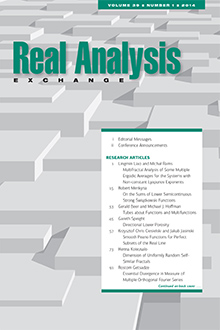Abstract
In the 1940’s, A. Denjoy proved that the typical point of a perfect nowhere dense set in \(\mathbb{R}\) is a point of strong porosity for that set. We prove two stronger versions of this for arbitrary metric spaces. Theorem 3 says that if \(E\) is any closed nowhere dense set in a metric space, and \(h\) is any porosity scale function, then the typical point in \(E\) is a point at which \(E\) is \(h\)-porous. Thus, if the metric space is complete, then “most” points of \(E\) are points at which \(E\) is very thin in the sense of porosity. Theorem 4 says that if \(F\) is closed and \(h\)-porous in \(\mathbb{R}\), then there exists a closed nowhere dense set \(E\) in \(\mathbb{R}\) containing \(F\) such that \(F\) is \(h\)-porous in the subspace \(E\). Therefore, in the sense of \(h\)-porosity, no nontrivial information about the porosity of a closed set in \(\mathbb{R}\) can be inferred from its porosity relative to some closed nowhere dense set in \(\mathbb{R}\).
Citation
Dave L. Renfro. "Porosity, nowhere dense sets and a theorem of Denjoy." Real Anal. Exchange 21 (2) 572 - 581, 1995/1996.
Information





